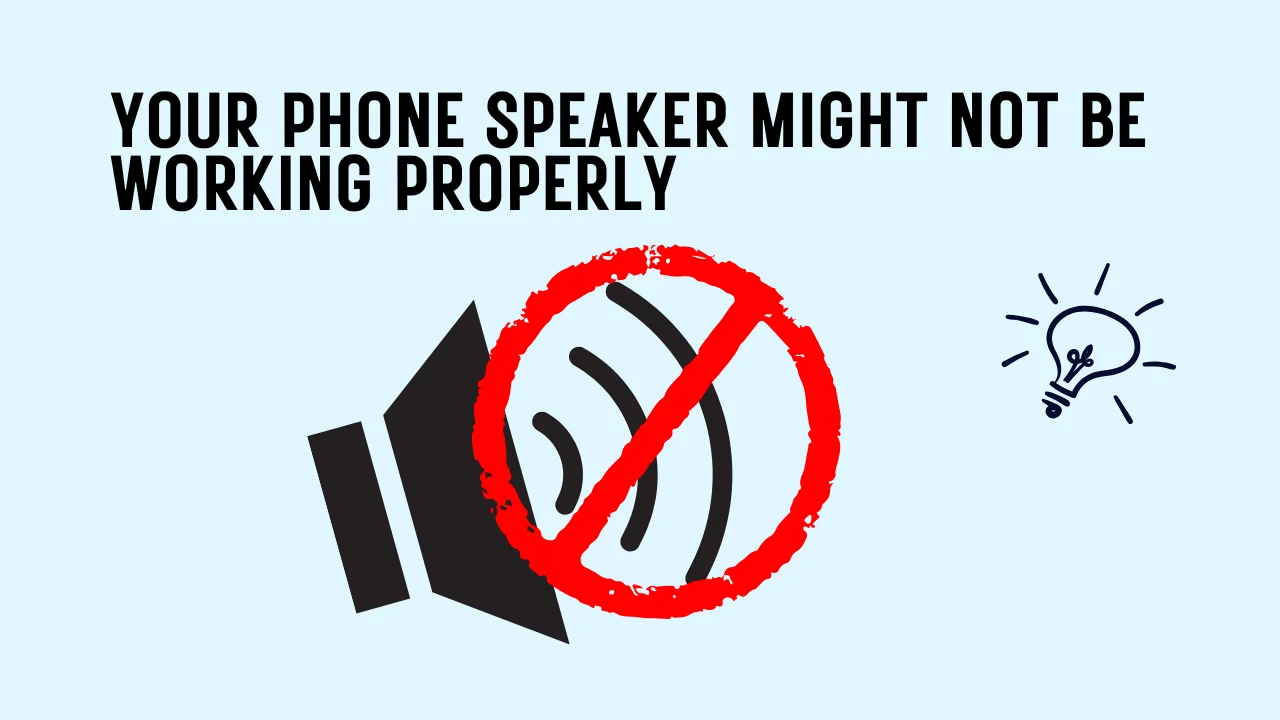Why Your Phone Speaker Might Not Be Working Properly

Is the speaker on your phone unclear or sounding low? It may seem broken to you, but that’s not always the case. The speaker holes may become obstructed by dust, water, or tiny particles of dirt. These factors weaken or muffle the sound.
You can often fix this without the need for tools or a repair shop. The first step is to identify the cause of the problem. It can be removed with a straightforward technique like using a phone speaker cleaner. We’ll walk you through simple and safe methods to restore your sound.
What Causes a Speaker to Sound Muffled or Low?
There is typically a straightforward explanation for why your phone’s speaker is not working. Over time, the speaker grill may become clogged with dust, pocket lint, or other small debris. The audio appears quiet or hazy as a result of the sound waves being blocked. The performance of your speaker can be impacted by even tiny particles of dirt.
Water is another frequent cause. Moisture can enter the speaker area through splashing, spilling, or using your phone with wet hands. This water may remain trapped, producing a quiet or hazy sound. If it is not removed, it might even result in long-term harm.
Why You Shouldn’t Use Sharp Tools or DIY Tricks
Using whatever they can find around the house, many people attempt to fix muffled speakers. Even though it might seem like a quick fix, if you use the incorrect technique, your phone could get seriously damaged. Heat, home cures, and these sharp objects can all exacerbate the issue or even cause it to become permanent. The top things people try (but shouldn’t) are listed below, along with the potential consequences of doing so.
Using Toothpicks or Pins Can Break the Speaker Mesh
Although they may appear harmless and small, toothpicks, pins, and other sharp objects can be dangerous. The speaker’s delicate mesh can be torn if you poke inside. Once that mesh is broken, your speaker is left vulnerable to additional dust and moisture. You risk breaking the speaker cone underneath, which will require costly repairs.
Blowing into the Speaker Can Push Dirt Deeper
Many people try to fix muffled speakers with whatever they can find around the house. Although it might appear to be a simple solution, if you use the wrong method, your phone could sustain significant damage. These sharp objects, heat, and home remedies can all make the problem worse or even make it permanent. Below is a list of the top things people try (but shouldn’t) and the possible outcomes.
Rice Can Leave Dust and Debris Behind
It’s a common belief that rice can pull moisture out of a wet phone. While it may help a little, it’s not designed for cleaning. Rice can break apart and leave fine dust or grains inside the speaker holes. This adds more debris instead of removing it, causing long-term sound issues.
Hairdryers and Heat Can Overheat Components
It is not a good idea to “dry out” your speaker with heat. Direct sunlight or hair dryers can cause your phone to overheat. It may cause your battery to swell, damage glue, or melt internal components. Heat raises the possibility of hardware damage but does not ensure water removal.
DIY Mistakes Can Make the Issue Worse
DIY solutions frequently only mask the underlying problem rather than resolving it. Over time, residual moisture or concealed debris can harm the speaker, even if the sound gets better for a while. If not handled properly, a minor problem could develop into a complete speaker failure. Therefore, it is always preferable to use safe and tried-and-true methods.
How to Safely Clean Your Speaker at Home
Cleaning your phone’s speaker at home doesn’t have to be difficult or dangerous. With the correct technique, you can actually enhance sound quality without damaging your device. No dangerous hacks or sharp tools, just easy steps you can follow in a few minutes. Here’s a safe and efficient way to do it.
Use a Phone Speaker Cleaner Tool
Try using a speaker cleaner that uses particular sound frequencies if water or dirt is still affecting your sound. These tools vibrate dust or water out of the speaker grill by playing pulsing audio. It’s among the simplest and safest methods for removing obstructions without coming into contact with the hardware. The rest is automatic; all you have to do is tap and play the sound.
Use a Soft, Dry Brush
A clean paintbrush or toothbrush with soft bristles can be used to gently clean the speaker grill. By doing this, surface dust is reduced without being forced deeper inside. Just make sure the brush isn’t too hard and is dry. Always move in a single direction and don’t apply too much pressure.
Try Gentle Air Flow (No Canned Air)
Instead of blowing forcefully or using a compressed air can, use a hand-squeeze air blower or a gentle puff of air from your mouth. By doing this, loose debris can be moved without endangering the speaker. To allow dirt to fall out naturally, try holding the phone at an angle. Avoid sealing the speaker hole because airflow should be indirect and light.
Check for Moisture Carefully
Look for indications such as low or distorted audio if your speaker sounds muffled and you think it might be water. Heat and hair dryers can cause more damage, so stay away from them. To help the moisture drip out, tilt the phone and tap it gently instead. Proceed to sound-based techniques for a more secure solution.
Repeat as Needed, Then Test the Sound
Play music or a test sound after cleaning to make sure the speaker is clear and loud. Repeat the safe procedures again if necessary. Steer clear of doing too many steps at once or cleaning too much. You’re done when your speaker sounds normal again!
Safe vs Risky Speaker Cleaning Methods
| Method | Safe or Risky? | Why? |
| Soft toothbrush/paintbrush | ✅ Safe | Gently removes dust without harming the mesh |
| Air blower (manual) | ✅ Safe | Soft air clears light debris without pressure |
| Sound-based cleaning tool | ✅ Safe | Vibrations remove water/dust without touching the speaker |
| Blowing air from mouth | ⚠️ Risky | May push dirt deeper or add moisture |
| Canned compressed air | ❌ Risky | High pressure can damage internal components |
| Toothpick or needle | ❌ Risky | Can puncture or tear the speaker mesh |
| Uncooked rice | ❌ Risky | Leaves behind particles and isn’t effective for deep cleaning |
| Hairdryer or heat source | ❌ Risky | Can overheat or warp phone parts |
Conclusion
The secret to enjoying crystal-clear audio every day is a clean phone speaker. Over time, accumulations like water and dust can infiltrate and degrade the quality of your sound. Regular care using safe techniques is therefore crucial. It helps safeguard both your listening experience and your phone.
Tools like a phone speaker cleaner can be very helpful when brushing alone isn’t enough. They don’t require any technical expertise and are simple to use. The full power of your speaker can be restored with just a few minutes of focus. You can prevent damage before it begins by starting small and taking action early.
FAQs
1. Why does my phone speaker sound muffled?
Your phone speaker may sound muffled because of dust, lint or water trapped in the mesh. These block the sound waves and reduce clarity. Using a soft brush or a sound-based tool can often fix the issue. Avoid poking it with sharp objects because that can do more harm.
2. Can water really damage my speaker permanently?
Yes, if water can corrode internal parts if it stays inside the speaker for too long. This damage isn’t always visible at first but can get worse over time. It’s best to remove the moisture quickly using a water eject sound or a drying method. The faster you act, the safer your speaker will be.
3. Is it safe to clean my speaker with a toothpick?
No, using a toothpick or any sharp item is risky. It can tear the fine mesh or push dirt deeper inside. Stick to safer methods like a soft brush or using a speaker cleaner sound tool that works through vibration. Your speaker will thank you.
4. How do I know if my speaker is full of dust?
If your sound gets lower or scratchy without warning, dust might be the cause. You can check it by shining a light at the speaker grill to check for buildup. A quick clean or test with a speaker clear tool can help restore volume and sharpness. Always go for non-invasive methods first.
5. What’s the easiest way to fix my speaker at home?
The easiest and safest way is to use a tool that plays a special tone to vibrate out debris. You can try it on our website. There are no apps, no downloads and no risk of damage. Just press play and let it do the job. If that doesn’t work, consider brushing lightly or checking for moisture.
